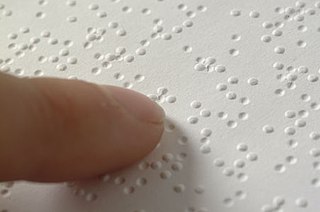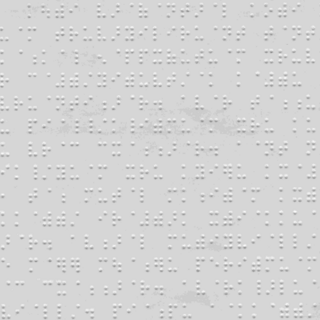
Braille is a tactile writing system used by people who are visually impaired, including people who are blind, deafblind or who have low vision. It can be read either on embossed paper or by using refreshable braille displays that connect to computers and smartphone devices. Braille can be written using a slate and stylus, a braille writer, an electronic braille notetaker or with the use of a computer connected to a braille embosser.

Hausa is a Chadic language spoken by the Hausa people in the northern half of Nigeria, Ghana, Cameroon, Benin and Togo, and the southern half of Niger, Chad and Sudan, with significant minorities in Ivory Coast.

Igbo is the principal native language cluster of the Igbo people, a meta-ethnicity from Southern Nigeria.

The culture of Nigeria is shaped by Nigeria's multiple ethnic groups. The country has 527 languages, seven of which are extinct. Nigeria also has over 1150 dialects and ethnic groups. The three largest ethnic groups are the Hausas that are predominantly in the north, the Yorubas who predominate in the southwest, and the Igbos in the southeast. There are many other ethnic groups with sizeable populations across the different parts of the country. The Kanuri people are located in the northeast part of Nigeria, the Tiv people of north central and the Efik-Ibibio are in the south south. The Bini people are most frequent in the region between Yorubaland and Igboland.

There are over 525 native languages spoken in Nigeria. The official language and most widely spoken lingua franca is English, which was the language of Colonial Nigeria. Nigerian Pidgin – an English-based creole – is spoken by 30 million people in Nigeria.

(Mainland) Chinese Braille is a braille script used for Standard Mandarin in China. Consonants and basic finals conform to international braille, but additional finals form a semi-syllabary, as in zhuyin (bopomofo). Each syllable is written with up to three Braille cells, representing the initial, final, and tone, respectively. In practice tone is generally omitted as it is in pinyin.
Tibetan Braille is the braille alphabet for writing the Tibetan language. It was invented in 1992 by German socialworker Sabriye Tenberken. It is based on German braille, with some extensions from international usage. As in print, the vowel a is not written.

English Braille, also known as Grade 2 Braille, is the braille alphabet used for English. It consists of around 250 letters (phonograms), numerals, punctuation, formatting marks, contractions, and abbreviations (logograms). Some English Braille letters, such as ⠡⟨ch⟩, correspond to more than one letter in print.
Nigerian English, also known as Nigerian Standard English, is a dialect of English spoken in Nigeria. Based on British English, the dialect contains various loanwords and collocations from the native languages of Nigeria, due to the need to express concepts specific to the culture of the nation.

Russian Braille is the braille alphabet of the Russian language. With suitable extensions, it is used for languages of neighboring countries that are written in Cyrillic in print, such as Ukrainian and Mongolian. It is based on the Latin transliteration of Cyrillic, with additional letters assigned idiosyncratically. In Russian, it is known as Шрифт Брайля.

Bharati braille, or Bharatiya Braille, is a largely unified braille script for writing the languages of India. When India gained independence, eleven braille scripts were in use, in different parts of the country and for different languages. By 1951, a single national standard had been settled on, Bharati braille, which has since been adopted by Sri Lanka, Nepal, and Bangladesh. There are slight differences in the orthographies for Nepali in India and Nepal, and for Tamil in India and Sri Lanka. There are significant differences in Bengali Braille between India and Bangladesh, with several letters differing. Pakistan has not adopted Bharati braille, so the Urdu Braille of Pakistan is an entirely different alphabet than the Urdu Braille of India, with their commonalities largely due to their common inheritance from English or International Braille. Sinhala Braille largely conforms to other Bharati, but differs significantly toward the end of the alphabet, and is covered in its own article.
Greek Braille is the braille alphabet of the Greek language. It is based on international braille conventions, generally corresponding to Latin transliteration. In Greek, it is known as Κώδικας Μπράιγ Kôdikas Brég "Braille Code".
The goal of braille uniformity is to unify the braille alphabets of the world as much as possible, so that literacy in one braille alphabet readily transfers to another. Unification was first achieved by a convention of the International Congress on Work for the Blind in 1878, where it was decided to replace the mutually incompatible national conventions of the time with the French values of the basic Latin alphabet, both for languages that use Latin-based alphabets and, through their Latin equivalents, for languages that use other scripts. However, the unification did not address letters beyond these 26, leaving French and German Braille partially incompatible and as braille spread to new languages with new needs, national conventions again became disparate. A second round of unification was undertaken under the auspices of UNESCO in 1951, setting the foundation for international braille usage today.

French Braille is the original braille alphabet, and the basis of all others. The alphabetic order of French has become the basis of the international braille convention, used by most braille alphabets around the world. However, only the 25 basic letters of the French alphabet plus w have become internationalized; the additional letters are largely restricted to French Braille and the alphabets of some neighboring European countries.
Turkish Braille is the braille alphabet of the Turkish language.
Several braille alphabets are used in Ghana. For English, Unified English Braille has been adopted. Four other languages have been written in braille: Akan (Twi), Ga, Ewe, and Dagaare. All three alphabets are based on the basic braille letter values of basic Latin alphabet:

Georgian Braille is a braille alphabet used for writing the Georgian language. The assignments of the Georgian alphabet to braille patterns is largely consistent with unified international braille.
The Yoruba alphabet is either of two Latin alphabets used to write the Yoruba language, one in Nigeria and one in neighboring Benin. The Nigerian Yoruba alphabet is made up of 25 letters, without C Q V X Z but with the additions of Ẹ, Ọ, Ṣ and Gb. However, many of the excluded consonants are present in several dialectal forms of Yoruba, including V, Z, and other digraphs. Central Yoruba dialects also have 2 extra vowels that are allophones of I and U. It is somewhat unusual in that the letter P usually transcribes, being only in restricted situations like onomatopoeia. The Beninese alphabet has the letters Ɛ and Ɔ, and previously had C.
Guosa is a constructed interlanguage originally created by Alex Igbineweka in 1965. It was designed to be a combination of the indigenous languages of Nigeria and to serve as a lingua franca to West Africa.









